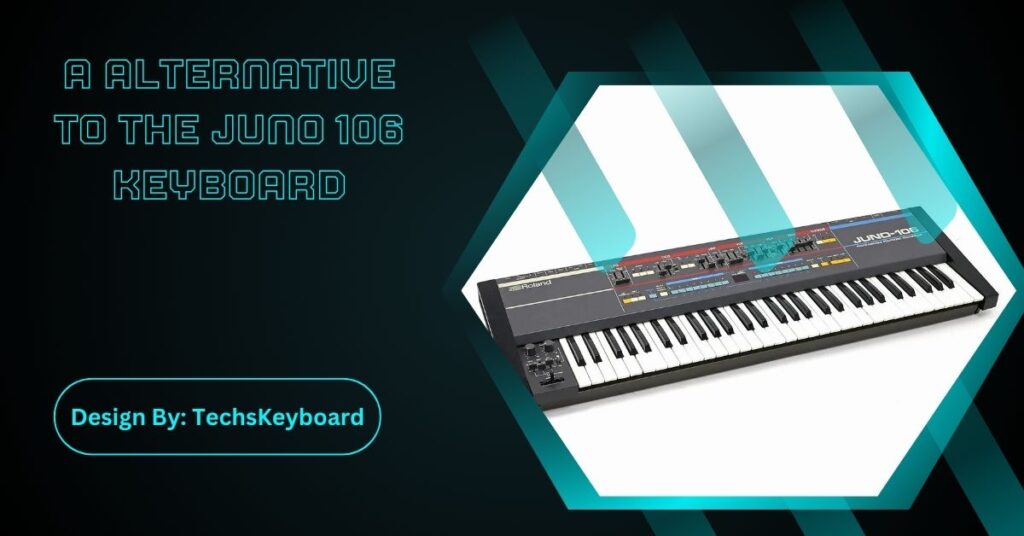The Behringer DeepMind 6 is an excellent modern alternative to the Juno 106, offering analog warmth, modern control, onboard effects, portability, and affordability for musicians seeking vintage tones with contemporary features.
Music has the power to transport us to other realms, to tell stories without words, and to evoke emotions we didn’t know we were capable of feeling. Among the tools that have shaped the musical landscape, few have made an impact as legendary as the Juno 106 Keyboard.
Revered for its lush analog sound and straightforward design, the Juno 106 became a staple in the 1980s and continues to hold a place of fascination for musicians and producers today.
But as timeless as the Juno 106 may seem, it isn’t without its challenges. From decreasing availability to rising prices due to its vintage status, owning and maintaining a Juno 106 can be more daunting than inspiring.
For many, finding an alternative that captures the essence of its sound while offering modern conveniences has become an alluring pursuit.
Why Look Beyond the Juno 106?
The Juno 106, while iconic, is not without its limitations. Its analog circuitry, as charming as it is, can create headaches for today’s musicians seeking reliability for live performances or hassle-free recording sessions. Vintage synths like the Juno 106 are prone to maintenance issues, such as voice chip failures, and many users have raised concerns about rising repair costs.
Additionally, its lack of advanced features—such as comprehensive MIDI functionality or extensive presets—means that modern musicians might find themselves craving the versatility of newer synths. Nostalgia aside, there’s no shame in seeking an alternative that bridges the past and present.
Unveiling Alternatives to the Juno 106:

Luckily, the market is brimming with keyboards that capture the Juno 106’s sonic charm while delivering adaptability, portability, and reliability. Here are a few alternatives worth exploring:
1. Roland Juno-DS61
Price Range: $700-$900
The contemporary descendant of older Juno models, the Roland Juno-DS61 is a powerhouse of features packed into a lightweight and portable body. It offers an array of lush synth sounds reminiscent of the original Juno series but adapts seamlessly to modern workflows. With built-in speakers, expanded sound libraries, and excellent MIDI control, this keyboard is a strong contender for musicians on the go.
2. Behringer DeepMind 6
Price Range: $600-$800
Often referred to as “Juno-inspired,” the Behringer DeepMind 6 is celebrated for its richness in analog warmth. Its six voices can be programmed to craft immersive pads and punchy basslines, reminiscent of the Juno 106. Unlike its older counterpart, however, the DeepMind offers extensive digital control and onboard effects.
3. Korg Minilogue XD
Price Range: $600-$800
Korg’s Minilogue XD is a favorite among synth enthusiasts for its hybrid analog-digital design. The polyphonic capabilities deliver silky-smooth sounds that rival the Juno 106, all wrapped in a user-friendly interface. With an OLED oscilloscope display and an endless playground for sound design, this keyboard has a uniquely modern twist on retro elegance.
4. Sequential Prophet Rev2 (8-Voice)
Price Range: $1,500-$2,000
For those willing to invest a bit more, the Sequential Prophet Rev2 is a creation that goes beyond just replicating the Juno’s sonic characteristics. Its silky analog tone and deep programmability put it in a class of its own. Whether you’re crafting dreamy 80s synths or experimenting with fresh, modern textures, the Rev2 offers a transcendent experience.
Highlighting the Best Alternative – Behringer DeepMind 6!
Of all the worthy options listed above, the Behringer DeepMind 6 takes the spotlight as the best alternative to the Juno 106.
Here’s why musicians are raving about it:
Analog Warmth Meets Modern Control
The DeepMind 6 channels the analog goodness of the Juno 106 while offering tools that make it adaptable in today’s fast-paced music production environments. Its incredible depth of sound programming keeps musicians inspired with every session.
Extensive Onboard Effects
While the Juno 106 relies on external gear for reverb and delay, the DeepMind 6 comes equipped with studio-grade effects from TC Electronic and Midas—all right at your fingertips.
Compact and Portable
Weighing in at just under 15 lbs, the DeepMind 6 is significantly more portable than the Juno 106, making it a dream companion for touring musicians or casual jam sessions at home.
Budget-Friendly
Offering pro-quality sound at a fraction of the Juno’s second hand price, the DeepMind 6 proves that quality and affordability can go hand in hand.
Also Read: What Is The Best Angle For Keyboard – Complete Guide!
Testimonials from Musicians:
Don’t just take our word for it—professional musicians and synth enthusiasts are saying the same!
“I was heartbroken when my Juno 106 broke mid-tour. The DeepMind 6 saved the day—it captures that same full, rich tone while being dependable night after night on stage!”
— Aria Porter, indie-pop keyboardist
“I always loved the Juno 106 but couldn’t justify the price tag. Then I discovered DeepMind 6. It checks all the boxes for sound without burning a hole in my wallet.”
— David Jansen, electronic music producer
“Programming patches is a breeze, and the results are pure magic. The DeepMind 6 feels like a love letter to vintage synths, with features any modern producer can appreciate.”
— Theo Cruz, touring musician and composer
FAQs:
1. Why consider an alternative to the Juno 106?
The Juno 106’s vintage nature brings reliability issues, high maintenance costs, and limited modern features, prompting musicians to explore alternatives with updated functionalities and lower upkeep.
2. What makes the Behringer DeepMind 6 a top alternative?
The DeepMind 6 combines the Juno 106’s analog warmth with modern features like onboard effects, deep programmability, portability, and affordability, making it ideal for both live performances and studio production.
3. How does DeepMind 6 compare to Juno 106?
While retaining similar analog tones, the DeepMind 6 adds studio-grade effects, MIDI control, and a compact, portable design, offering more versatility and reliability for today’s musicians.
4. Are there other alternatives to the Juno 106?
Yes, options include the Roland Juno-DS61, Korg Minilogue XD, and Sequential Prophet Rev2. Each provides a unique take on vintage sounds with modern features to suit diverse needs.
5. Is the DeepMind 6 suitable for live performances?
Absolutely! Lightweight and reliable, the DeepMind 6’s portability, rich tones, and onboard effects make it a go-to choice for touring musicians and live performers.
Conclusion:
The Juno 106 remains an iconic synth, but modern alternatives like the Behringer DeepMind 6 provide vintage-inspired tones with contemporary reliability. Offering deep programmability, built-in effects, and portability, it bridges the gap between nostalgic soundscapes and modern production needs. For musicians seeking affordability and adaptability, the DeepMind 6 and similar options like the Korg Minilogue XD prove that the legacy of the Juno 106 lives on in exciting new forms.


